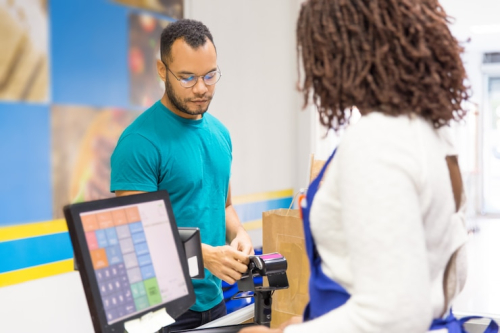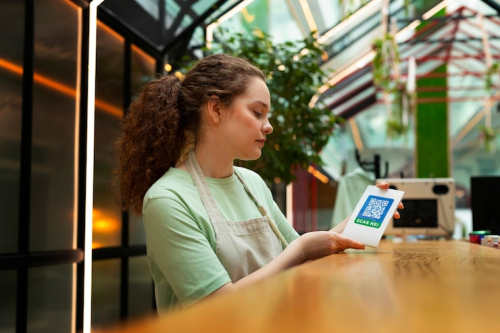Quick Listen:
From AI-driven kitchens to seamless guest experiences, cutting-edge technology is transforming the hospitality industry at an unprecedented pace.
The restaurant industry, once defined by the rhythmic clatter of kitchen tools, is now powered by the quiet efficiency of digital systems. Point-of-sale (POS) terminals, automated inventory trackers, and AI algorithms analyzing customer preferences are driving a monumental shift. The global restaurant technology market, valued at $5.1 billion in 2024, is projected to reach $17.16 billion by 2032, growing at a compound annual growth rate (CAGR) of 16.39%. This transformation is not a fleeting trend but a fundamental evolution, fueled by consumer demands for seamless online ordering, mobile payments, and personalized dining experiences. For restaurant operators and technology developers, the imperative is clear: embrace innovation or risk obsolescence.
The Rise of Digital Dining
Step into a modern restaurant, and the future is palpable. Self-service kiosks process orders in seconds, while kitchen display systems (KDS) replace handwritten tickets, enhancing communication between front-of-house and back-of-house teams. The restaurant management software market, valued at $4.2 billion in 2021, is expected to soar to $17.1 billion by 2031, with a CAGR of 15.3%. Cloud-based platforms, which generated $2.4 billion in 2021, are projected to reach $11.1 billion by 2031, offering scalable solutions for payment processing, inventory management, and demand forecasting.
Consumer expectations are the catalyst for this digital surge. Diners now prioritize convenience, favoring mobile apps for pre-ordering and contactless payment options that eliminate delays. The restaurant digitization market, worth $6.9 billion in 2022, is on track to hit $23.4 billion by 2030, driven by innovations like digital kitchen boards and automated inventory software. Restaurants are no longer solely about culinary offerings; they are hubs of efficiency, data-driven decision-making, and elevated guest experiences.
Smart Kitchens: Efficiency Meets Innovation
Picture a kitchen where robotic arms prepare dishes and sensors monitor inventory down to the last ingredient. This is the reality of smart kitchens, which are reducing labor costs and food waste through automation. Touchless cooking stations and AI-driven analytics are becoming standard in fast-casual chains, with smart inventory systems having been shown to reduce food waste significantly. The restaurant technology solutions market is expected to grow at a CAGR of 18.55%, reaching $18.79 billion by 2030, as operators leverage AI for staffing, menu optimization, and personalized promotions.
AI is the backbone of these advancements, enabling predictive analytics that adjust pricing based on ingredient costs or recommend upsells tailored to customer preferences. For instance, a regular vegan diner might receive a prompt for a new plant-based dish, enhancing satisfaction and boosting revenue. These technologies streamline operations while creating a more personalized dining experience, aligning with the evolving demands of today’s consumers.
Revolutionizing the Ordering Process
The days of flagging down a server are fading. Digital ordering ecosystems voice-activated kiosks, branded mobile apps, and table-side tablets are redefining how customers interact with restaurants. The digital food management market is projected to reach $5.48 billion by 2029, with a CAGR of 13.7%, driven by the proliferation of food delivery platforms and smartphone adoption. Major chains like Chipotle have embraced this shift, introducing digital-only kitchens and mobile pickup lanes that reduce wait times while gathering valuable customer data.
Smaller operators are also capitalizing on these trends. Cloud kitchens, supported by white-label ordering platforms, enable entrepreneurs to launch virtual restaurants with minimal investment. A local café can now rival larger competitors by offering online ordering and delivery through third-party apps, all integrated with cloud-based POS systems. This democratization of technology is leveling the playing field, empowering independent restaurateurs to thrive in a competitive landscape.
Building Loyalty Through Engagement
Modern diners seek more than a meal they crave connection. Omnichannel engagement tools integrate social media, email, SMS, and loyalty programs to create cohesive customer experiences. A diner might receive a personalized discount via text after sharing their meal on social media or a birthday offer through email. These strategies drive retention and increase revenue, with personalized offers significantly increasing restaurant revenue when implemented effectively.
Sustainability is also gaining traction. Smart waste-tracking systems minimize food scraps, while energy-efficient appliances reduce costs. Some POS systems even connect with suppliers to prioritize sustainable ingredients, appealing to environmentally conscious consumers. These initiatives enhance brand loyalty while aligning with global sustainability goals, creating a compelling value proposition for restaurants.
Navigating Challenges
Despite its potential, restaurant technology faces significant obstacles. Legacy systems, such as outdated POS terminals, often struggle to integrate with modern platforms, leading to operational inefficiencies. Cybersecurity is another critical concern, as restaurants handle sensitive payment data and must comply with regulations like GDPR and CCPA. A single data breach can severely damage a brand’s reputation.
Staff resistance poses an additional challenge. Employees accustomed to traditional methods may resist adopting new systems like KDS, particularly in smaller establishments without robust IT support. Moreover, the cost of implementing digital tools can be prohibitive for independent restaurants. The restaurant management software market, valued at $5.69 billion in 2024 and projected to reach $28.03 billion by 2034, highlights the significant investment required. Balancing these costs with tight profit margins remains a persistent challenge.
Seizing Opportunities
The benefits of restaurant technology are transformative. Data-driven personalization enables tailored guest experiences, from recommending desserts to recalling seating preferences. Workflow automation, such as reservation systems linked to supply chain trackers, reduces labor costs and enhances efficiency. Cloud-based platforms provide scalability, allowing multi-unit operators to manage operations seamlessly from a single dashboard.
Domino’s exemplifies this success, with its AI-powered pizza tracker and GPS-optimized delivery setting a benchmark for transparency and speed. Smaller brands are following suit, using cloud kitchens and smart inventory systems to compete cost-effectively. Industry data shows that restaurants adopting digital tools can achieve significant efficiency improvements.
The Future of Food Service
Industry experts predict a future where technology becomes invisible, seamlessly enhancing the guest experience. Web3 loyalty programs using blockchain and augmented reality menus that display 3D dishes are on the horizon. Real-time staffing algorithms, which adjust schedules based on traffic patterns, are already in testing. The restaurant digitalization market, projected to reach $29.6 billion by 2032 with a CAGR of 16.3%, reflects the scale of this transformation.
For 2025, experts recommend starting with scalable platforms that integrate with existing systems. Prioritizing customer experience through faster checkouts and personalized offers yields significant returns. Backend efficiencies, such as optimized supply chains, can also deliver substantial savings, making technology a strategic investment for restaurants of all sizes.
Embracing the Digital Edge
The restaurant industry has always evolved, adapting to new tastes and cultural shifts. Today, technology is the defining factor, enabling early adopters to turn data into revenue and digital interactions into lasting loyalty. Restaurateurs and software developers must collaborate closely, merging culinary expertise with technological innovation. As you tap an app to order takeout or scan a QR code for a menu, you’re participating in a revolution that’s reshaping food service one byte at a time.
Disclaimer: The above helpful resources content contains personal opinions and experiences. The information provided is for general knowledge and does not constitute professional advice.
You may also be interested in: 3rd Party Delivery Fees: Fair or Burden?
Scattered systems and manual processes erode your restaurant’s margins daily. Milagro unifies POS, digital menus, online ordering, staffing, loyalty, and AI-powered marketing into one platform, slashing costs and enhancing guest loyalty. Reclaim control over operations and drive revenue growth. Streamline your workflow and elevate profitability. Schedule your Milagro demo today!
Powered by flareAI.






